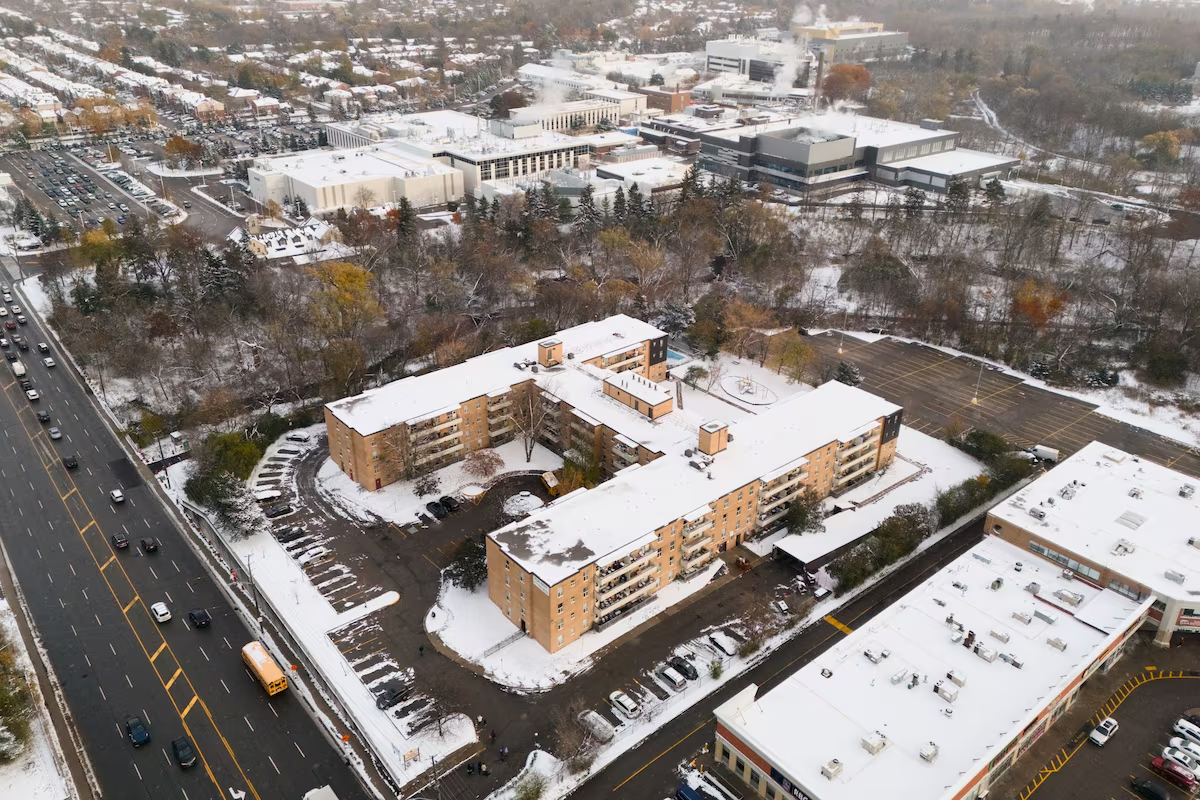Ontario moves to block plans for Toronto apartment complex near Sanofi pharma facility

Open this photo in gallery:
The site of a proposed three-building residential apartment complex in Toronto near a Sanofi manufacturing facility. Tenblock Development Inc. says Ontario is seeking to use a rarely deployed power to block the plan.Sammy Kogan/The Globe and Mail
A Toronto real estate developer says the Ontario government is using a rarely deployed ministerial power on behalf of a global pharmaceutical manufacturer to block plans for a new rental apartment complex.
Tenblock Development Inc. has proposed three residential buildings of 14, 33 and 39 storeys that would replace an existing four-storey apartment building it owns on Steeles Avenue West in north Toronto. The redevelopment site is near a pharmaceutical manufacturing facility owned by Sanofi Pasteur Limited, which employs more than 2,000 people. Sanofi SNY-Q, which is headquartered in Paris and has a large presence in Canada, has a market capitalization of close to $100-billion.
On Oct. 14, Ontario’s Ministry of Economic Development, Job Creation and Trade filed an application on behalf of the pharmaceutical giant for a Ministerial Zoning Order, or MZO, to “safeguard the continued operational viability” of the facilities.
The order is limited to Tenblock’s property and requests any new buildings be limited to 33 metres high, or about 10 storeys – far less than the developer’s current proposal. The ultimate decision lies with Rob Flack, Ontario’s Minister of Municipal Affairs and Housing, who has the power to issue MZOs.
“We followed the planning process for five years. Now we understand the province is considering moving the goalposts and now 960 new apartments are at risk,” said Stephen Job, vice-president at Tenblock.
The MZO request seeks to curb the development beyond the height limit, saying the ministry would consider planning tools to protect the facility from “encroachment of non-employment uses and development on adjacent lands, given its strategic importance to Ontario, and would consult on those measures as appropriate.”
An MZO is a potent but infrequently used authority to override local planning rules – which cannot be appealed and has never been subject to a successful court challenge – that became better known in 2022 amid the scandal over MMAH issuing 15 new regulations to remove Greenbelt protections from almost 3,000 hectares of land owned by private real estate developers.
Despite a reversal from Premier Doug Ford 10 months later, the potential abuse of the ministerial powers over land use remains the subject of an open RCMP investigation.
Canada’s rental market has gotten cheaper, but that won’t last
The public comment period for the MZO request on Tenblock’s property ends on Thursday, after which Mr. Flack can issue a decision at any time.
Peter Smith, a private-sector planning expert with Bousfields Inc., said in a submission on behalf of Tenblock that while the law allows cabinet ministers other than the housing minister to apply for MZOs, granting one in this case would represent a misuse of power because there was no evidence of “rationale on why the project requires ministerial zoning relief rather than following the typical planning process.”
In July, 2024, Toronto City Council rejected the recommendations of its planning staff and voted down Tenblock’s application after Sanofi warned a 30-storey building raised national security issues in a letter to council: “The location of hundreds of new residential units with a 24/7 overlook of its sensitive facilities undermines Sanofi’s ability to ensure its ongoing and expanding vaccine research and manufacturing facilities are secure.”
In response, Tenblock hired security consultancy Juno Risk Solutions Inc. to write a report about the risks posed by a tall building to a pharmaceutical plant. Sanofi’s concern “defies logic,” according to Juno’s president and chief executive officer Andrew Chester.
Open this photo in gallery:
The site of the proposed apartment complex at at Steeles Avenue West with Sanofi’s building in the background.Sammy Kogan/The Globe and Mail
In a submission to the province, Juno stated, “National security or business security concerns are neither created or worsened by a proposed development.” The submission features diagrams of several other locations where existing tall buildings that overlook sensitive sites pose a much greater security risk, including another site Sanofi expanded in 2022 in Cambridge, Mass.
Normally, planning applications that are approved by city staff but rejected by council can be revisited through an appeal to the Ontario Land Tribunal. While Tenblock filed an appeal, the tribunal has yet to hear the matter and an MZO would override that review.
Sanofi declined to answer questions about why it wasn’t making the MZO request on its own or whether it had co-ordinated with the provincial government. It released a statement stating: “We appreciate the Government of Ontario’s commitments to the life sciences sector and look forward to continuing – and expanding – our vital work in safeguarding public health and supporting the Canadian economy.”
In 2021, the federal government announced it was giving $415-million to assist Sanofi in building a new influenza vaccine manufacturing line at the Steeles site, a project that Ontario’s government also funded with $55-million in tax dollars. That part of the plant opened in 2024.
“As a critical player in Ontario’s growing life sciences sector, the requested Minister’s Zoning Order will ensure their expansions move forward without unnecessary delays, creating more good-paying jobs in the process,” said Jennifer Cunliffe, spokesperson for Victor Fedeli, Progressive-Conservative MPP for Nipissing and the Minister of Economic Development, Job Creation and Trade.
Open this photo in gallery:
Sanofi’s pharmaceutical manufacturing facility in Toronto on Monday.Sammy Kogan/The Globe and Mail
James Pasternak, the city councillor for ward six, where the factory is located, said that while Sanofi has raised the issue of security, there are other considerations at play.
Among those issues are potential complaints from residents on issues such as smells or noise, which could in turn interrupt its operations.
“When you have that many residents it triggers complaints, that in itself triggers all kinds of investigations,” said Mr. Pasternak, who said the MZO was necessary to avoid compromising the plant’s future viability. “In the minds of the leadership in Paris, this is a strategic preventative measure to make sure that plant can operate safely and successfully.”
Mr. Job said Tenblock is willing to find a way to work with Sanofi, but an MZO like this would effectively kill its plans.
“No one has ever explained to us what the problem is or why it needs to be solved with an MZO. We haven’t seen a shred of evidence or technical analysis supporting the idea that our apartment buildings somehow threaten a factory that’s already surrounded by homes and public spaces,” Mr. Job said.
“And our apartment building in the Sanofi factory have co-existed for over 50 years.”
First Capital REIT – which is preparing a zoning application to allow a residential building on a parcel of commercial land next to Tenblock’s apartment building – also submitted a letter to the ministry asking it to reject the MZO and cited Sanofi’s failure to engage in the public planning process.
“First Capital has made several attempts to engage Sanofi Pasteur to better understand the particulars of their concerns, especially the alleged impacts of mixed-use development on the Sanofi Pasteur lands,” wrote Joshua Butcher, a senior director for development at First Capital.
“We have also expressed a willingness to look at revising our proposal to resolve or mitigate the alleged impacts. Regrettably, our efforts have been consistently rebuffed.”
Editor’s note: A previous version of this article incorrectly referred to moves by the Ontario Ministry of Municipal Affairs and Housing (MMAH) to remove greenbelt protections in Ontario as overrides by the Ministerial Zoning Order, or MZO, process. The removal of protections was the result of the MMAH issuing 15 new regulations.




